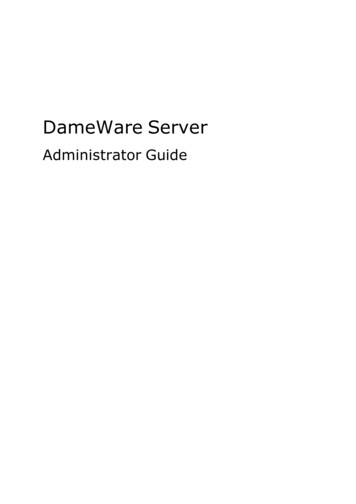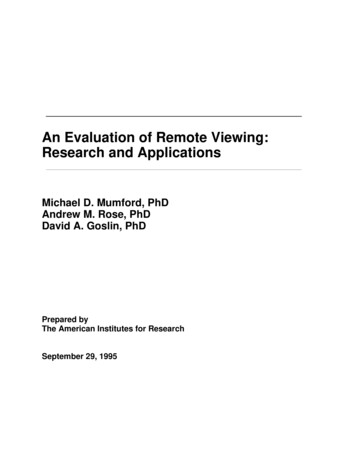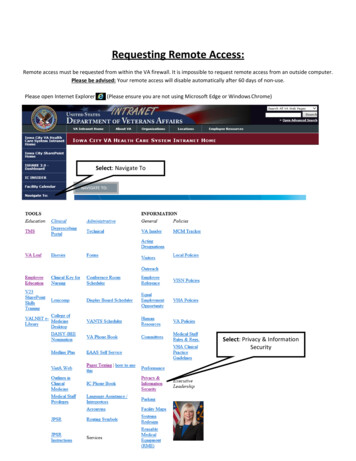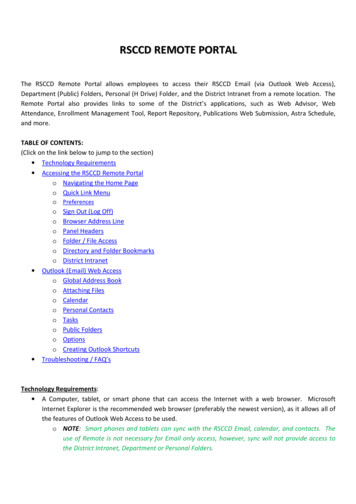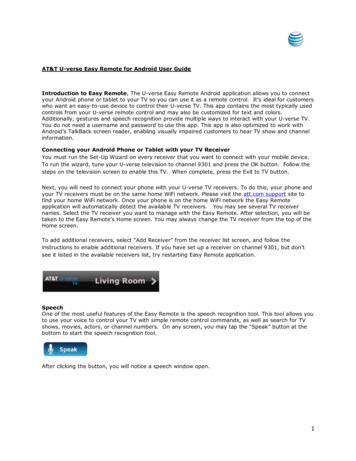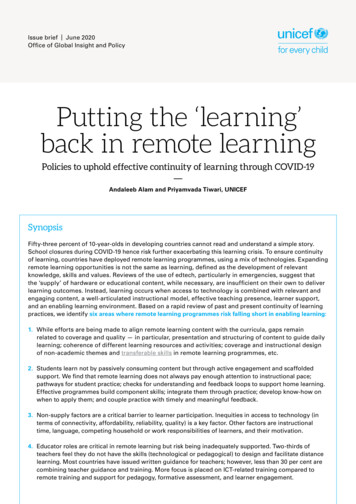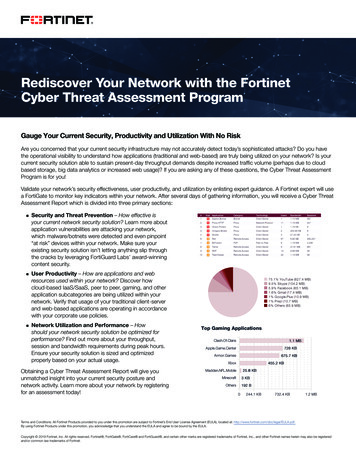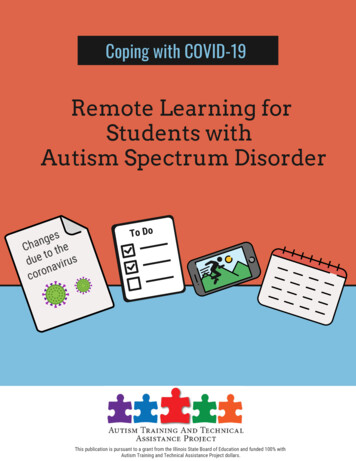
Transcription
Coping with COVID-19Remote Learning forStudents withAutism Spectrum DisorderesgnCha thetodue virusnaorocTo DoThis publication is pursuant to a grant from the Illinois State Board of Education and funded 100% withAutism Training and Technical Assistance Project dollars.
The spread of the novel coronavirus has resulted inunprecedented changes to the daily lives of children andfamilies. We realize these changes may be particularlychallenging for individuals with autism spectrum disorder(ASD), who tend to thrive on consistency, structure, androutine. Many learners with ASD may face challengesrelated to comprehension, communication, difficultyunderstanding abstract language, an insistence onsameness, and a greater likelihood of anxiety anddepression - all of which may be exacerbated during thisstressful time. Many also require specially designedinstruction to support their educational needs and dailyfunctioning. As such, the Autism Training and TechnicalAssistance Project at Illinois State University has compiledautism-specific resources for individuals with ASD and theirfamilies as they navigate remote learning. It is our hopethese resources can help provide ideas and support familiesas they develop new routines within their homes.The following support strategies are designed to meet theunique needs of individuals with autism spectrum disorderduring this period of uncertainty. In addition, examples andready-made resources are included to help caregiversimplement these strategies quickly and easily. Links areprovided for downloading as well as multiple file-formats(when possible) for manipulation.These materials represent a variety of examples to modelthe range of what may be most meaningful across ages andskills. Specific adaptations and additions may be necessaryto best meet the varied needs of individual children andyoung adults.Some content adapted from Hume, UNC School of Education & UNC FPG Autism Team, 2020 and Bock & Michalak, 2014
These strategies are a resource of ideas to help families andcaregivers through these unpredictable days and help makeremote learning easier. While it might take some time andeffort, YOU know your child best. Families and caregiversabsolutely have the ability to not only provide a supportiveand safe environment but have fun while doing it!As you consider these resources, initially only choose 1 or 2strategies to try. It may be easiest to start with a strategy thathas been used in the past or find a support strategy to addressan issue that is creating the most immediate stress. After afew days or weeks, consider adding another strategy. Don'toverwhelm yourself or your child- we don't want to add stressby putting too much in place too quickly. Consider involvingthe individual with autism in the decision-making processabout what strategy would be most helpful.Support UnderstandingSupport BehaviorOffer Opportunities forExpressive CommunicationSocialize RemotelyEstablish a Daily Scheduleand Create RoutinesTips for Remote LearningIdentify a Location forRemote LearningAdditional Resources3
Support UnderstandingIndividuals with autism may have varying levels of understanding about the COVID-19virus, how it spreads, and how to reduce risk of exposure. Below are several strategies touse to provide additional meaning to this complex scenario.Describe the coronavirus and current situationUse concrete language and terms and avoid abstract phrasing. The understanding ofabstract phrases and metaphors such as “she is under the weather”, “she caught thevirus”, and “he is scared stiff about this” can be difficult for individuals with autism andcan create confusion (Lipsky, 2013). Using direct and clear language is recommended.Phrases like “The coronavirus is a type of germ. These germs are very tiny, and when theyget inside your body, they can make you sick” may be easier for individuals with autism tounderstand.Use a social narrative, a story that describes social situations byproviding relevant cues, explanations of the feelings and thoughtsof others, and descriptions of appropriate behavior. Individuals onthe autism spectrum benefit from receiving information inmultiple formats, as they often have receptive language deficits.Several examples of social narratives have been developed togive individuals more information about COVID-19, help themunderstand how to reduce risk, provide insight into how they maybe feeling, and offer assurance that those feelings are normal.Reading the narratives to/with the individual with autism regularlyacross several days is helpful. Revisit often and modify asneeded.CoronavirusCOVID-19Resources to Support UnderstandingSocial Narrative Resources:How to Write Social Stories by Vanderbilt Kennedy CenterMake a Social Story Fact Sheet4Adapted from Hume, UNC School of Education & UNC FPG Autism Team, 2020
Support UnderstandingSocial Narrative ExampleWhat is the Coronavirus?The coronavirus is a new virus. Sometimes people call it COVID-19.A virus can make people sick. When someone has the coronavirus, they mayhave a bad cough, have a fever, and may have diarrhea. Just becausesomeone is sick doesn't mean they have the coronavirus. There are otherviruses that make people sick. The cold and flu are caused by a virus.If someone has the coronavirus they will have to stay away from otherpeople. They will stay home and rest. They don't want to spread thecoronavirus and get other people sick.To protect myself, I will wash my hands. I will put soap on my handsand scrub my palms, the back of my hands, my fingers and count to 20.1, 2, 3, 4, 5, 6, 7, 8, 9, 10, 11, 12, 13, 14, 15, 16, 17, 18, 19 ,20When I am done counting to 20, I can rinse the soap off with waterand dry my hands. I can use hand sanitizer if I can't wash my hands. Iwill be washing my hands a lot to keep germs away. I also will keepmy hands away from my face. If I have to touch my face, I willremember to wash my hands first. I don't want to get germs on myface. I won't touch my nose or my eyes unless I have just washed myhands. And then, I will wash my hands again.6 feet apartI also need to stay away from other people. It's okay to be near people that I livewith, but I can't see friends right now. I can't see friends because I want to protectmyself and not pass germs to my friends. If I do see another person, I will stay 6feet away.5
Offer Opportunities for Expressive CommunicationChildren and young adults may have difficulty articulating how they feel about the manyunexpected changes. Fear, frustration, and worry may be expressed through challengingbehavior like tantrums, refusing to take part in family activities, or withdrawal. Forindividuals with ASD, communication difficulties may be coupled with expressivecommunication delays, limited verbal or nonverbal skills, difficulty with perspective-taking,and/or social communication deficits.Consider providing expressive communication supportsWhen stress and anxiety levels increase, many individuals with ASD who use verballanguage may lose the ability to access their works and, instead use their behavior tocommunicate. Recognize that an increase in challenging behaviors may be an expressionof anxiety or fear. Consider asking your child's teacher about the strategies implementedin the classroom that support expressive communication. There are many communicationsupport strategies that can help when there may be a breakdown in expression.Promote social communicationPromote social communication and personal independence. Try to set up highlypreferred activities in hard-to-reach places, in clear containers with labels that havewords or pictures identifying what they are. This encourages children to intentionallycommunicate their wants. At the same time, if you want your child to continue practicingskills (for example, making own snack), increase easy access by leaving materialswithin easy reach or setting up clear labels and stations for them.Resources to Offer Opportunities for Expressive Communication6Adapted from Hume, UNC School of Education & UNC FPG Autism Team, 2020
Offer Opportunities for Expressive CommunicationWays to support expressive communicationCheck to see how your childfeels when they hear aboutthe coronavirus.What do I want to eat?Choice board tohelp communicatefood selection.7
Establish a Daily Schedule and Create RoutinesIt is helpful for all children and adults to establish a new routine with a defined scheduleand structure for the day. A daily schedule organizes the child's environment and createspredictability. For individuals with ASD, change, transitions, and new routines might behard. Creating a schedule will allow the individual to see what is coming next throughoutthe day and may help to lessen some challenging behaviors that may emerge due to a lackof routine.Putting in place a new schedule, particularly when things are quicklychanging, means things won't be perfect, and that is okay!Schedules don't need to be fancy, laminated or have velcro. Use aformat that works for your child. Some students use pictureschedules or written schedules. Use a schedule that is best for yourchild. The most important thing is to develop a clear structure androutine that can be easily understood. Post the schedule on the wall,place it on a table where work is completed, or in another easy-toaccess place and let it guide the day.Consider creating a scheduleDevelop a modified version of the child's typical schoolroutine that is adapted to the home environment. Start withthe first class or subject and structure an at-home 'remotelearning day' routine that follows the order of the child'stypical school day. This is also dependent on each child.When developing the schedule, list the activityor the expectation. Be sure to balancestructured activities with fun things to do, hardtasks followed by easier and more enjoyableactivities. Be sure to go over the scheduleeach morning and review it during the day toshow what is coming next. As activities pass,provide an opportunity to check off completedactivities and tasks. And, don't forget; it willtake time to get used to the new schedule!8
Establish a Daily Schedule and Create RoutinesExample SchedulesWork schedule outliningactivities to becompleted on top row.When task is completed,child pulls off icon andputs in Work Done.Reward earned when alltasks are completed.Weekly Scheduleoutlining remotelearning. Checkoff when activityis finished.Written dailyschedule withhand drawingand posted onfridge.9
Establish a Daily Schedule and Create RoutinesExample SchedulesFirst Then VisualSchedule HD iPad App.Written remotelearning scheduleon dry eraseboard.Written remotelearning schedule,check-off whenactivity is done.10
Establish a Daily Schedule and Create RoutinesTips for keeping a regular routineWith being home each day, it could be easy to stop keeping a regular schedule or throwoff normal sleep habits and eating times. Do your best to keep your day as similar tousual as possible. Consider keeping the same morning and evening routines, the samelunchtime, and include breaks. The schedule will help create new routines. Routines canprovide increased comfort for individuals with autism and teach independence.Build in time for physical activityIncorporate physical activity breaks, including fine and gross motor activities toencourage both physical and mental well-being. You can also use this time for familyconnection by doing activities outside together – choose an activity your child enjoys ortry an at-home workout (search YouTube for family-friendly workouts and yoga classes).Schedule and plan these breaks and model a habit of regular daily physical activity.Add household chores to the scheduleSchedule time for cleaning and housework. Chores are a great way to encourageprogress in daily living skills. This may be an opportunity to take advantage of extra timeat home together, where you can demonstrate and teach more independent living skillsand offer abundant praise and reinforcement for successes.Create a weekly calendarWhen everyone is home indefinitely, understanding more concretely days that are“learning” days rather than “family” days can help decrease anxiety and give children asense of order. Maintaining a regular schedule during the closure will also make it easierfor your child to transition back to school when it re-opens.Be patient and realisticStart small, with more 'loose' structure, if that feels less overwhelming. Involve yourchildren in planning for their learning and creation of the schedule when possible. And,remember to schedule breaks – for everyone – throughout your day.Adapted from Autism Speaks COVID-19 Information, 202011
Establish a Daily Schedule and Create RoutinesExample VisualsCleaning checklistsMonthly calendarindicating NoSchool, RemoteLearning at homeResources to Establish a Daily Schedule and Create Routines12
Identify a Location for Remote LearningIn addition to creating and using a schedule, try fostering an environment that allows forengagement in specific activities.Consider the environmental arrangementDesign specific areas where activities and remote learning will take place. This will helpdefine what activities take place in which location. It might be helpful to label the areaand materials so there is an understanding of what activities will occur in each location.Labeling provides another way to add structure and routine to the area. Set aside partsof your living space where academics can occur and a different space for recreationactivities.RemoteLearning AreaBreak AreaFor some learners, it might help to keep their schoolworkin their backpack and keep it in the area designated forremote learning. If your child has strong tactile sensoryinterests, keep a few sensory toys that they can interactwith in a specific area. This way, you can make sure thatthese toys are regularly sanitized, and you can teach yourchild how to regulate sensory needs.Resources to Identify a Location for Remote Learning13
Support BehaviorBehavior is a form of communication. Some individuals with ASD may not be able toverbally express their fear, frustration, and anxiety about the many changes and/or theirhealth, so these expressions may be demonstrated through other means. Research showsthat during times of high anxiety, our ability to use spoken language to reason is reduced.Providing access to visual supports can help a student learn to self-regulate during adifficult time. Even individuals who use spoken language might engage in challengingbehavior when their stress and anxiety levels increase. It's important to look beyond thebehavior to identify what the child is trying to tell you.Ways to support behavior during remote learningProvide positivereinforcementIdentify multiple rewards and providepositive reinforcement for good andappropriate behavior. Use behaviorspecific praise.Respond calmly ifchallenging behavioroccursIf your child is engaged in challengingbehavior, it is important to stay calm. Ifyou express anger or frustration, it mayresult in more challenging behavior fromthe child. Remaining calm will provide thesafety and support as the child learns tocalm themselves.Select a strategy that canhelp prevent challengingbehaviorSome examples include Rule Cards,ChoiceBoards,First-Then,SocialNarratives, I'm Working For board, a timer,and positive reinforcement.Help the child understandtheir emotions and teachthem to self-calmSelf-regulation is the ability to manageemotions and behavior in accordancewith the demands of the situation. It'simportant to teach the child the copingskills they need to learn to calm. Modelcoping skills and positive self-talk.14
Support BehaviorReinforcement and MotivationAsking your child to do schoolwork at home can be challenging. It helps to havesomething to motivate the child to get their work done. You can do this by arranging thechild's schedule so that remote learning tasks come before the fun activities (forexample, "First schoolwork, then outside play"). You can also set up an incentivesystem for your child to work to earn something. As adults, we work for a paycheck andthat paycheck is our reinforcer. Give your child the same opportunity to work forsomething they want. Here are ideas on how to use reinforcement at home:Identify manyreinforcersbased onchild'spreferencesIdentify reinforcement and offer rewards: Make sure you havereinforcers your child wants to work for and have enough of thereinforcers to last through the upcoming weeks. For example, if yourchild likes building legos, allow them to work for a few minutes andthen have time to play legos. It's helpful to use a timer. A kitchentimer or set an alarm on your phone works great. Most children like avisual time so they can see how much time remains.Timing: When the child has finished remote learning tasks, give thereinforcer right away. You want to immediately reinforce because if Reinforcementthe child has to wait for it, they will be less likely to do their workshould benext time. You may also want to consider increasing how often the IMMEDIATEreinforcer is delivered throughout the day to increase the behaviorsyou want to see more.First-Then: A first-then board shows the student what they need to do first and then,what they will do next. Usually, the first activity is work and the second activity issomething the child wants to do. This follows the Premack principle, where first youhave to do something in order to get something. The child learns (pretty quickly) whenthey complete their work, then they get the reinforcer they wanted.15
Support BehaviorI'm Working For chart: This is a token system where the child earns tokens (pictured hereas stars) towards a reward of their choice. The tokens can be something the child likesor enjoys such as a favorite toy or character from a show or movie. This can be utilizedin remote learning by having the child earn a token after each completed activity on theschedule.Punch Card: A punch card is another individualizedsupport. A caregiver can give out punches forexpected behavior or task completion, and after acertain amount of punches, the child earns areinforcer. Sometimes getting the punch ismotivating and rewarding.Follow RulesWork HardEarnMOVIE nightA few different systems have been overviewed. Set up a clear system that hasimmediate, tangible rewards after the completion of a desired behavior. This can bedone in small steps like the First-Then board. Or the system can be more complex, suchas earning tokens throughout the day that add up to a certain menu of rewards at theend of the day like screen time, cuddle time or a recreational activity of their choice.Create Rules for Remote Learning TimeMany students with ASD rely on rules and routines tokeep their environment predictable and to helpunderstand what is expected. Consider developingrules to help define expectations during remotelearning. Identify 3-5 rules that describe the expectedbehavior. Be specific when describing the behavior use concrete language. Be sure to post the rulesvisually so you can teach them to your child andreference them when a reminder is needed. It'simportant to point or gesture to the rules instead ofusing a verbal prompt. And REINFORCE when you seeyour child following the rules.16
Support BehaviorReview your child's Individualized Education Plan (IEP) and BehaviorIntervention Plan (BIP) to identify supportsOne of the biggest challenges parents and caregivers may face is managing challengingand severe behavior. Whether it's a child refusing to do schoolwork at home, or throwinga full-blown tantrum, it might be easy to find yourself at a loss for an effective way torespond.If your child has an effective behavior plan that can be successfully used in the homesetting, families and caregivers should continue to implement the plan as written. Ifthere are concerns or questions about how to implement the plan, reach out to yourchild's teacher or case manager to identify ways to create a safer environment andproblem-solve proactive behavior support strategies that can be implemented during thistime.If your child with ASD has any aggressive behaviors, ensure that your family has a plan inplace so that everyone at home knows what to do if they ever feel unsafe. This mightmean creating a “safe space” in your home where they can go (for example, theirbedroom).We are experiencing an unprecedented moment in history and for a family with a childwith severe and challenging behavior, the circumstances are that much more difficultand dangerous. The primary goal for families is to keep everyone as safe as possibleand to avoid any need for medical attention, considering the current situation in ourhospitals. Hopefully, the many examples to support behavior can help prepare for andpotentially avoid a behavioral crisis and allow everyone to feel safe during this time.Keep the main thing, the "main thing" - family, safety, and emotional and physical health#1.Calming strip to help child takedeep breaths. You can modeltaking deep breaths, too. Thisis a great idea for everyone topractice.Resources to Support Behavior17
Socialize RemotelyIndividuals with ASD are more susceptible to social isolation and loneliness, and thismay be worsened by shelter-in conditions. Positive social support is important foreveryone during this period, and individuals with autism may need more explicitfacilitation to ensure that social connections continue. Caregivers may need to check into help identify who close friends are and help develop a plan about how to connect.Consider sharing contact information with a teacher to pass to a classmate. With manyoptions available via text messaging, FaceTime, Google Hangout/Meet, and other apps,the individual needs to figure out which forms of socialization will work best: if you hatephones, don’t call people. This might be a time when the individual learns to be creativeand try things that aren’t immediately comfortable. Try to vary how you communicate:don’t just use video chat or only text. Use all the resources at your disposal.Schedule time to connect with others via online platforms to attend spiritual services,play chess, participate in socially engaged gaming, complete online schoolwork, orvirtually volunteer are ways to safely promote social interaction and stave off isolation.With several examples provide support around using apps that can fosterconnectedness.WritingWrite an actual letterShare compliments or kind words withfriendsLet friends know if you’re struggling andneed supportOffer help whenever possible: it can boostyour moodCreate challenges with your friends (photochallenges, cooking challenges, etc.)Use your extra time to reach out to peopleyou miss or haven’t had time to see latelyVideoVideo chat Facetime, Google Hangouts,Zoom meeting, etc.Watch parties: start a movie or TVshow at the same timeOnline games: try online cooperativegamesHave dinner with friends over videoTry changing up your videobackground: if you want to simulate acoffee shop date, make your houselook like a coffee shopResources to Socialize Remotely18
Tips for Remote LearningCommunicate and collaborate with your child's classroom teacher as you plan forinstructional time, if possible.Be familiar with the goals and objectives that are included in your child's IEP.Think about your child's strengths and needs. Always begin with successful activities.Incorporate activities that your child is good at mixed with activities you might beteaching for the first time.Incorporate activities that your child is good at mixed with activities you might beteaching for the first time.Deliver positive reinforcement as often as you can. Reinforce for sitting, trying,following through, finishing, and even just staying with you.We teach math (counting, adding, subtracting, etc.), reading (identifying and namingletters, letter sounds, sounding out words, reading simple words and sentences, etc.)and writing (copying letters, writing name, etc.) But, there are many additional skillsthat can be targeted during this instructional time. A few ideas include:Imitation skills, put-in tasks, copying, matching, sorting, labeling pictures,following directions, pointing to pictures, learning how to play with toys,turn-taking, communication skills, fine motor skills (stringing beads, copyingor tracing shapes, using scissors, tracing/writing letters) listening to a story,answering questions after a story, learning how to play a game, role playsocial skills, everyday functional skills (grooming, cooking, cleaning) andreally anything you would like your child to learn that would supportindependence.19
Tips for Remote LearningUse items around your house – Below are examples that might elicit additional ideas:For Early Learners:Use a bowl and spoon to practice imitation, use socks to practice matching, use cansof food to give directions (examples: put on chair, put in sink, put on table), use familyphoto albums to point to pictures, and use cups to practice stacking.Don’t be afraid to play during academic time! Planned PLAY is a way for us to showour early learners how to use toys, how to share, how to take-turns, etc. We know thisis how our early learners acquire skills. Keep in mind some students may needspecific instructions on how to play or specific modeling demonstrating the desiredplay skills. Other students may need full support through the movements until theyacquire the skills needed.For Intermediate Learners:Practice writing family names, phone numbers, point to pictures in magazines,practice following directions around the house and consider daily living skills forsuch as: picking up toys, washing dishes, putting away the dishes, folding towels,etc.For Advanced Learners:Read new recipes, read a chapter of a favorite book, make an outline and drawpictures to share with the rest of the family, write letters, and consider daily livingskills such as laundry, cooking, yard work, etc.Don’t underestimate yourself. You know your child better than anyone.Resources for Tips for Remote LearningAdapted from Supporting All Learners: Resources for Families and Caregivers of Children with Special Needs,Autism and Tertiary Behavior Supports, 202020
Additional ResourcesResources from National ASD OrganizationsLinks to national websites with evidence-based ASD resources, including COVID-19specific resources for families, educators, administrators, and community partners.Autism Collaborative Centers of Excellence (ACCE)Online Webinar Series for Parents, Teachers & CaregiversAutism Focused Intervention Resources & Modules (AFIRM)Supporting Individuals with Autism through Uncertain TimesAutism Science FoundationCOVID Resources for FamiliesCOVID Resources for ResearchersCOVID Resources for Service ProvidersAutism Society of AmericaCoronavirus: Response & ResourcesCouncil for Exceptional Children (CEC)Resources for Teaching RemotelyWebinar: Teachingin Online Duiring COVID-19COVID-19 Considerations for Special Education AdministratorsOhio Center for Autism & Low Incidence (OCALI)Resource Gallery of Interventions To Support Families During the COVID-19 CrisisUC Davis Health & Mind Institute‘Help is in Your Hands’VCU Autism Center for ExcellenceResources for individuals with ASD and their Family Members during the COVID-19 Closure.Waismen CenterDealing with Covid-19 Resources for Special Educators, Therapists, & Families21
For questions or additional resources,please contact:Nikki Michalaknakempe@ilstu.edu
unprecedented changes to the daily lives of children and families. We realize these changes may be particularly challenging for individuals with autism spectrum disorder (ASD), who tend to thrive on consistency, structure, and routine. Many learners with ASD may face chall



